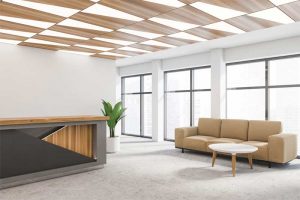
by Ken Woolf, PE
It is possible to restore discolored, aged acoustical ceilings instead of replacing them with brand new materials when budget is limited or there are time restrictions.
Whether a ceiling is composed of an acoustical plaster or conventional ceiling tiles, the majority of aged acoustical ceilings are still structurally sound. The ‘less-than-new’ appearance is because of the deteriorated condition of the surface coating on the ceiling—it is no longer white because of exposure to ultraviolet (UV) light and/or contamination. Random water stains may have also degraded the appearance. In such instances, a new surface coating can be applied without compromising the favorable properties of an acoustical ceiling, such as sound absorption, and in the case of ceiling tiles, unimpeded access above the ceiling for maintenance purposes.
However, standard paint products should not be used for this purpose. Acoustical ceilings are designed to absorb sound. Standard paints bridge the pores of the material, thus inhibiting the sound absorption process. Further, and in the case of a suspended ceiling, the tiles are left stuck to the supporting T-bar system due to the dried paint, forming a film between the tile and T-bar. This compromises the ability to perform routine maintenance activities above the ceiling (i.e. electrical/telephone wiring and HVAC). Also, some paints can negatively affect the flame spread rating, an important design consideration.
Advanced acoustical coatings can modestly improve the sound absorbing quality of the ceiling and retard the flame spread (in case of a fire). In the white color, they disperse light sufficiently to reduce the dependence on artificial luminaires and have a longer life cycle than conventional ceiling paints, resulting in an impressive return on investment (ROI).
Acoustical coatings presently available have several capabilities including:
- improves the noise reduction coefficient (NRC) by 9.1 percent;
- is a Class-A fire retardant (reduces the flame spread rate by 80 percent and smoke development by 50 percent);
- improves dispersion of light by 8.6 percent over a new tile;
- is non-toxic with minimal volatile organic compounds (VOCs); and
- holds its whiteness index longer and at a higher level than the coating originally applied by the product manufacturer.
It is important to note all of the testing referenced by the author’s company was performed in their white color.
Testing
In the case of an acoustical coating, the following test results, referencing independent laboratories, should be easily provided by a reputable product manufacturer/supplier:
- acoustical testing: what affect will the application of the coating have on the ability of the substrate to absorb sound;
- fire test: what affect will the application of the coating have on the surface burning characteristics in terms of retarding the rate at which the flame spreads and how much smoke is developed as a result of surface burning;
- light reflectance: what change (positive or negative) will occur in the surface’s ability to disperse light;
- toxicity testing (a requirement in some states): when the coating material burns, does it give off toxic gas; and
- aging tests: how long will the product hold its white color as compared to other materials that are similar in nature?
LEED credits
By restoring the existing ceiling materials and by using the qualifying acoustical coating, credits under the Leadership in Energy and Environmental Design (LEED) can be earned. To qualify, the coating must avoid or diminish solid waste disposal (recycling the old materials) and possess an acoustical coating with a low VOC rating (Credit 3.1 and 3.2 – Resource Reuse and Credit 4.2 – Low Emitting Materials: Paints and Coatings).




